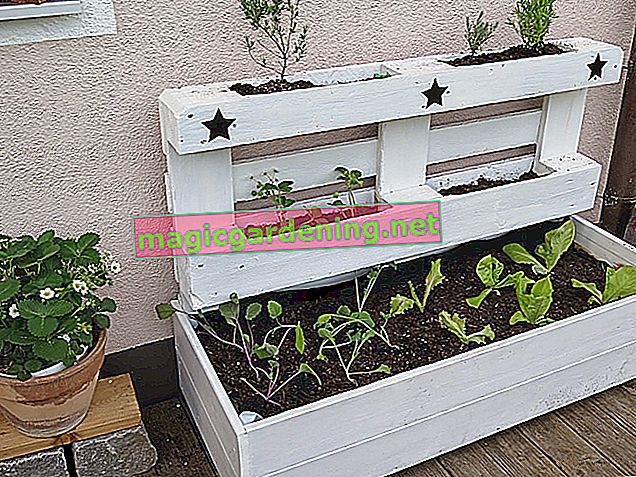
Green light for many types of cuts
A pronounced cut tolerance makes it possible to control the rapid and expansive growth of a wisteria. At a young age, the Asian growth rocket gives its gardener the green light for a strategic education. You can keep adult wisteria in check with a maintenance cut in a double pack. Even the radical rejuvenation cut shows the wisteria balanced. Such a tolerance of pruning encourages creative gardeners to train to become a spectacular standard. The following table summarizes all types of cuts with recommended dates:
also read
- How to cut forsythia in an exemplary manner - tutorial for the correct cut
- Exemplary cutting of a snowball - tutorial for the perfect cut
- How to cut garden hibiscus exemplary - cutting tutorial for beginners
| Cut type | Goal / occasion | Appointment option I. | Appointment option II |
|---|---|---|---|
| Educational cut climbing aid | strategic construction on pergola and trellis | February | Late summer (August / September) |
| Summer cut | Reduce growth, create order in the network of branches | two months after the end of flowering | no |
| Winter pruning | Preservation of vitality and young blossom wood, clearing of dead wood | Late January to late February | no |
| Taper cut | Revitalize neglected, aged wisteria | Late winter to early March | no |
| Upbringing high trunk | Raising wisteria to be a tree | Late January to late February | Late summer (August / September) |
Please only decide to plant a wisteria in your garden if you have sufficient time to prune it twice a year. Wisteria comes with a vehement growth of up to 2 meters annually. The climbing artist can easily crush rain pipes, bend balcony railings and tear climbing aids out of their anchoring. Regular, strategically clever blending slows down growth, reduces weight and directs the mighty tendrils into a harmonious, balanced design.
Parenting cut - tailored to the pergola and trellis
After planting, it takes a few years for the wisteria to bloom for the first time. Wisteria grown from seeds sometimes take eight years to bloom. Those who do not want to be patient can plant grafted varieties or varieties grown from cuttings. The young shrubs bloom earlier and more profusely. On the way to the first heyday, cut care is dedicated to tailor-made upbringing . The aim is to build a basic structure that will last a lifetime and support the short blossom wood. Regardless of the type of growth chosen, it takes three to five years to erect the scaffolding.
The cut depends on whether you are raising the wisteria on a pergola or on a trellis as a facade greening. Direct growth in the right direction from the start. You can do this with just a few, clearly defined scaffolding shoots, which you can gradually extend over the first three to five years. A wisteria always creates the flower buds for the next year in the summer of the previous year on the new shoots that sprout from the perennial scaffold shoots. If you leave the climbing plant alone without training , you will struggle within a few years with an impenetrable tangle of intertwined shoots. The professional training on the pergola and trellis is explained in more detail below:
Education on pergola and rose arch
- Select the two strongest shoots as future scaffold shoots
- Attachment to the climbing aid with plant binders
- Extend each scaffold shoot in February by a maximum of 100 centimeters
- Loosen the shoot extensions after the cut and tie them again
You extend the main shoot by about 1 meter per year. To do this, trim last year's growth in February to the desired extension. Cut specifically at a short distance to a bud. In this way, you cause a sap build-up below the cut, which stimulates your wisteria to form side branches. After the upbringing, the pruning leads to two maintenance pruning on the side branches, as explained in more detail in this tutorial.
Education on the trellis
- Attach wall trellis at least 15 centimeters away from the facade
- Determine the strongest instinct as the main instinct
- Shorten the main shoots to a height of 70 to 90 centimeters
- Apply scissors just above one strong eye
- Remove all side shoots
- Fix the shortened guide shoot on the wall trellis
In the first summer of the upbringing phase, leave two side shoots that you attach to the wall trellis at an angle of 45 degrees. Cut off all remaining side shoots. You prune the main shoot itself every winter so that it becomes a maximum of 100 centimeters longer per year. Proportional to the increase in height, direct the next pair of side branches diagonally upwards in summer. Shorten all branches of the side shoots to 15 centimeters. All other shoots along the main shoot are removed. Use this strategy until the wisteria has enough pairs of side shoots to fill the trellis. It is important to note that you boldly remove all superfluous side shoots so that a clear structure develops and the plant does not become too heavy for the supporting trellis.
Summer pruning slows growth
Two months after the end of flowering, it is high time to create order in the network of shoots of a wisteria and encourage the formation of new flower buds. As illustrated in the figure below, the side shoots are the target of the loppers. How to do the perfect summer cut:
- Cut side shoots back to a length of 30 to 50 centimeters
- Place scissors a few millimeters above an outward-facing bud
- Unwind trimmed shoots from the climbing aid and tie again
- In the following period, break out the green shoots by hand
For the summer pruning, please visualize the desired structure of a few leading branches with selected side shoots. When a guide branch has reached the desired length, trim the tip of the shoot as if it were a side shoot. After pruning, mulch the soil with compost or bark humus.

background
Remove water shoots promptly - tips about the unpopular type of instinct
The most magnificent wisteria are the result of a successful refinement. Premium varieties such as 'Blue Dream', 'Pink Ice' or 'Macrobotrys' thrive on a robust game base. When a substrate drifts through, strong-growing wild shoots sprout into the sky, which in technical jargon are called water shoots. Water shoots compete with the precious part for nutrients and water. At the same time, they strive with all their might to overgrow the noble variety. Remove wild shoots consistently and promptly. The unwanted shoots can be identified on a different leaf shape and a place of origin near the ground.Winter pruning promotes abundance of flowers
After the summer pruning, the wisteria will create flower buds for the next year. These are located at the base of shortened side shoots and are initially inconspicuous and hardly recognizable. That will change by late winter. From February onwards, young flower buds swell clearly and can be clearly distinguished from leaf and shoot buds. The optimal time window for the winter cut is open between the end of January and the end of February / beginning of March. As the illustration below demonstrates, the process facilitates professional cutting. How to do it right:
- First clear all dead, weak or frozen branches
- In the summer , prune any shoots that have already been shortened to 2 or 3 buds
- Shorten scaffolding shoots with the desired final height to 10 centimeters from last year's growth
- Result: over the years formation of thickened heads with valuable blossom wood
The thickened heads are the starting point for short shoots. The longed-for flower buds are located at the base of these short shoots. At least for 10 to 15 years, the thickening remains vital and spared from cutting measures. After this time has elapsed, these heads age and are locally rejuvenated with the help of a discharge. Cut off flowering branches where a young short shoot branches off. If a dense, aged clump has formed, remove it completely.

Digression
The time of cutting influences the strength of the growth
The choice of date for cutting on wisteria influences the intensity of the subsequent growth. The later in the year you cut a wisteria, the more reserve material has already been released from the rootstock into twigs and branches. This results in a reduced sap pressure and the new shoot is correspondingly weaker. Conversely, the earlier you cut, the stronger the shoot. If you subject a wisteria to a maintenance pruning in February , the wisteria reacts with a markedly stronger growth than in late summer , when the pruning is aimed at a growth calming anyway .Rejuvenate neglected wisteria
If gardeners allow wisteria without pruning care, an impenetrable thicket with a few flower clusters is created within a few years . That is no reason to clear the Asian flower wonder. With a radical rejuvenation cut, you turn back time on your wisteria and rebuild the climbing plant. This is how the plan works:
- The best time is in late winter between December and February
- Check wisteria for wintering animals before cutting and cut later if necessary
- Remove all branches except for two suitable scaffold shoots
- Shorten the side shoots along the remaining scaffold shoots to 10 centimeters
- The tips of the scaffold shoots lead to a young side shoot in the lower half
How deep you cut back the two remaining scaffold shoots depends largely on the type and variety. If you rejuvenate a refined wisteria, the refined point must not be removed. As a rule, the neuralgic point is about 50 centimeters high. If in doubt, please ask the nursery from which the plant came.
Rejuvenate wisteria in winter
A rejuvenating cut in summer is taboo. In order to protect breeding birds, the Federal Nature Conservation Act generally prohibits radical cuts in all types of wood. The central closed season extends from March 1st to September 30th . Slight maintenance cuts, such as the summer cut on wisteria, are permitted as an exception because only this year's growth is cut. Radical measures such as rejuvenation and thinning are permitted by law from October 1st to February 28th, provided that wild animals cannot overwinter in the woods in advance.

Tips
A strong pruning inevitably leaves large cuts in an old wisteria. In the modern home garden, wound closure has had its day. According to well-founded research results, herbal healing methods outperform any wound sealing with tree wax. (€ 5.99 on Amazon *) Smooth out larger cuts with a knife and leave the rest to your wisteria.
Education to the standard
A wisteria thrives as a strong-growing liana with thick branches that are suitable for the tree trunk. Over the years, the lignification progresses so intensely that a support is no longer required. Creative home gardeners take advantage of this property of wisteria to develop the climbing plant into a spectacular tree. A grafted young plant offers the best starting position because it flowers earlier and more profusely than a pure Wisteria species. How to proceed correctly step by step:
- Tie the strongest central shoot as a tree trunk to a support post
- For later braiding, select two or three strong ground shoots and fix them to a support
- Remove all remaining shoots
- Trunk shoots on the support pole lead to the desired height
- Only cut off the stem tip when the tip bud is enthroned 4 to 6 buds above the base of the crown
- Cut off side shoots below the crown at the base
An ideal wisteria high trunk thrives with a strong (optionally braided) trunk and a crown of four to six leading branches. Until a crown branch has reached the required diameter, use a strong wire to direct the growth in the desired direction and shape. During the training phase, cut off all side shoots seamlessly in order to promote growth in thickness. The wire can only be removed when a crown branch can bear the weight of short shoots and flower clusters. The side shoots of the crown branches are pruned twice a year, as is recommended for climbing plants. The only difference to be noted is the winter pruning. Do not shorten the side shoots that have already been trimmed in summer to 2 or 3 buds, but to 1 to 2 buds,respectively a length of 5 centimeters.
Digression
Cutting wisteria with bypass or anvil scissors?
Good secateurs are the gardener's loyal companion when cutting wisteria. The shop shelves are filled to the brim with one-handed scissors, which mainly differ according to the bypass and anvil mechanism. Bypass shears work with two sharp cutting edges and are ideally suited for the summer cutting of this year's green shoots. The anvil scissors work with a sharp edge that meets a blunt counterpart. This mechanism reduces the effort required and is perfect for winter pruning lignified or dead branches.frequently asked Questions
Is the wisteria poisonous?
Wisteria contain various ingredients that are toxic to humans and animals. The bark and roots are permeated with toxic wistarin, which is absorbed through the skin. The wearing of long-sleeved clothing and gloves is strongly recommended for cutting work. Lectin in pods and seeds can cause severe headaches after consumption, as well as vomiting, nausea and abdominal pain. If larger amounts get into the human organism, it can lead to circulatory collapse and cardiac arrest. Since the pods burst with a loud bang, they magically attract children. Therefore, wisteria is not recommended for the family garden.
Are there any differences between Chinese wisteria (Wisteria sinensis) and Japanese wisteria (Wisteria floribunda)?
Chinese wisteria conquers climbing aids as a left-winding climbing artist. The shoots of Wisteria sinensis therefore wind counterclockwise. The up to 50 centimeters long, seductively scented panicles of flowers shine from May to June, even before the pretty pinnate leaves sprout. In contrast, a Japanese wisteria thrives as a right-winding climbing plant. Wisteria floribunda consequently winds clockwise. The wisteria species bloom between April and the beginning of June with 30 to 50 centimeter long flower clusters, while the leaves sprout at the same time. With regard to the care of the cut, the differences are not important.
Can you pull the wisteria up with a braided main trunk or does the plant turn out again by itself? Do you need 2 wisteria next to each other for braiding?
The upbringing of wisteria with a braided main trunk is easily possible. As the wisteria winds its way up, we recommend that you first let all the shoots grow individually and then braid. Regular pruning will provide a sufficient amount of shoots from the lower area to braid later. You can therefore get by with a wisteria.
Our pergola is not particularly large at 2.50 meters. Can I prune the wisteria so much every year that it stays correspondingly small?
You can easily do this by cutting twice a year. For the first time, prune the wisteria two months after flowering by shortening the side shoots to 30 to 50 centimeters. In February, the winter pruning is dedicated to the resulting new flower stems, which you cut down to 2 or 3 buds. At this point you can easily see the flower buds because they are noticeably swollen just before the budding begins.
Can I grow noble wisteria 'Pink Ice' in a tub?
In general, keeping wisteria in buckets is not a problem, provided that important premises are taken into account. To ensure the supply of water and nutrients, the bucket volume should be at least 25 liters at the beginning. The bucket size must be adjusted in proportion to the growth. The larger you grow the wisteria, the larger the volume of the bucket should be. Ideally, repot a noble wisteria in conjunction with the winter pruning.
Is wisteria hardy and thrives in cool locations?
Winter weather with frost and snow can usually not harm a wisteria, as long as the location is sheltered from the wind. As a natural protection against the cold and wet, we recommend underplanting evergreen ground cover, which shields the shallow root system of a wisteria. However, severe late frosts can affect the young shoots and buds. If meteorologists announce belated frosts in April and May, cover a wisteria with fleece. To strengthen a robust winter hardiness, please stop fertilizing in August so that branches and twigs are well matured before the first frost.
What diameter should a climbing aid made of wood or round steel have in order to withstand the choking force of wisteria?
A wisteria does not choke so much as it rotates the supports of its climbing support due to its looping growth. In the long run, wood has no chance of staying straight as a wall trellis for wisteria. In practice, a 10 x 10 centimeter post was twisted more than 90 degrees and ultimately broke through. With round steel there is a better chance that the climbing aid will withstand. Solid steel with a diameter of 2 centimeters is recommended. Thick, stretched wire that is well anchored in the ground has proven itself. Once the scaffolding shoots of a wisteria are thick enough, they provide additional support.
The 3 most common mistakes
A blooming wisteria with a dense network of long whip shoots is hardly reminiscent of the magnificently flowering climbing plant from the nursery and garden center. The cause of the disappointing performance are classic mistakes in the care of the cut. To make your wisteria a highlight in the garden, there are three common cutting mistakes you should avoid:
| Cutting errors | Damage | prevention |
|---|---|---|
| no parental cut | uncontrolled growth, few flower clusters, damage to climbing support and facade | Wisteria grow with few scaffolding shoots |
| cut too little | Long lashes grow as a dense network, few or no flowers | Cut vigorously twice a year |
| Water shot not removed | Wild stock overgrown noble variety | Cut or tear off wild shoots promptly |
Home gardeners make another cutting error when transplanting a wisteria. The older the plant when changing location, the more root mass is lost. So that the mighty climbing plant compensates for the loss, all above-ground parts of the plant must be shortened by around half. The best time is in early spring, so that the pruning removes a large part of this year's flower buds. If you do not cut back a transplanted wisteria by half for this reason, you will struggle with a weak, blooming plant or its total failure.
YoutubeTips
Wisteria does not only express its vigor above ground. In the sunny, nutrient-rich location, the magnificent climbing plant forms numerous, quite annoying runners. So that wisteria does not subdue the entire garden through this "back door", it should be planted with a root barrier. A depth of 60 to 80 centimeters with a diameter of 100 to 120 centimeters is well suited.








